材料概论试卷(A)
材料学概论考试题与参考答案

材料学概论考试题与参考答案一、单选题(共75题,每题1分,共75分)1.下面哪个不是限制陶瓷广泛应用的因素( )A、脆性B、原材料稀少C、难加工D、工艺复杂,成本高正确答案:B2.若想通过分子量分布改性,使高分子的强度和耐冲击性提高,则需要设计什么样的分子量分布( )A、窄分布,高分子多B、窄分布,低分子多C、宽分布,高分子多D、宽分布,低分子多正确答案:A3.以下用途中主要利用的是光致发光的荧光材料的是?( )A、彩色电视机B、电子显微镜C、白光LEDD、场发射显示器正确答案:C4.磁控气体放电,磁场的作用是:( )A、维持体系的低真空B、加快电子的运动速率C、利用磁场改变二次电子的运动轨迹,增大电子撞击气体产生离子的概率D、提高电子的能量正确答案:C5.陶坯烧结前一般___( )A、涂釉B、不涂釉正确答案:B6.碳浓度低于共析钢为亚共析钢,高于共析钢为过共析钢,那么,共析钢中碳的质量分数是?( )A、1.77%B、3.77%C、0.77%D、2.77%正确答案:C7.铁(Fe) 的核外电子排布式是?( )A、1s22s22p63s23p63d74s1B、1s22s22p63s23p63d8C、1s22s22p63s23p63d64s2D、1s22s22p63s23p63d84s2正确答案:C8.纺丝是合成化学纤维成型的关键工艺,常见的三种纺丝工艺是( ) .(1)干法纺丝(2)湿法纺丝(3)熔体纺丝(4)切片纺丝A、(1)(3)(4)B、(2)(3)(4)C、(1) (2) (4)D、(1)(2)(3)正确答案:D9.高压钠灯采用透明氧化铝陶瓷而不用玻璃的原因是( )A、相比玻璃,氧化铝有更好的热导率B、高温高压的钠蒸气会腐蚀含钠的玻璃或石英玻璃C、氧化铝陶瓷的透明性比玻璃好D、氧化铝陶瓷比玻璃便宜正确答案:B10.下列哪一种泵能达到的真空度最高( )A、扩散泵B、涡轮分子泵C、溅射离子泵D、机械泵正确答案:C11.缩聚反应得到聚合高分子的同时还会产生小分子,下面的缩聚反应得到的小分子和其它三个不同的是( )A、尿素和甲醛缩聚成脲醛树脂B、苯酚和甲醛缩聚成酚醛树脂C、己二酸和己二胺缩聚成尼龙6,6D、对苯二甲酸甲酯和乙二醇缩聚成聚酯纤维(PET)正确答案:D12.真空的特点不包括( )A、压强低B、分子密度小C、平均自由程大D、没有任何气体分子正确答案:D13.按照真空区域的划分,10-5~10-9Pa属于什么真空区间( )A、超高真空B、中真空C、极高真空D、高真空正确答案:A14.以下金属中熔点最高的?( )A、钨(W)B、钼(Mo)C、锆(Zr)D、镍(Ni)正确答案:A15.常见的高分子聚合反应方法有4种,涂料合成常用( )A、本体聚合B、溶液聚合和乳液聚合C、悬浮聚合D、固相聚合正确答案:B16.润湿作用不包括以下哪个?( )A、铺展B、浸湿C、沾湿D、增溶正确答案:D17.不同的钢种,特别是经过不同的热处理,硬度变化很大。
材料学概论考试模拟题

材料学概论考试模拟题一、单选题(共75题,每题1分,共75分)1.以下属于III-IV族化合物半导体的是?( )A、HgSB、GaNC、MgSD、ZnO正确答案:B2.钢与生铁的主要差别是含碳量不同,生铁中碳的质量分数一般在3.5%-4.5%,那么钢中碳的质量分数一般小于多少?( )A、3.11%B、1.11%C、4.11%D、2.11%正确答案:D3.α-Fe的晶格结构是?( )A、面心立方结构B、密排六方结构C、密排三方结构D、体心立方结构正确答案:D4.在热处理工艺中,将钢或合金加热至适当温度,保温一段时间以获得不同要求的高温相,然后快速冷却,获得远离平衡状态组织的工艺,是哪一种热处理方法?( )A、正火B、回火C、退火D、淬火正确答案:D5.氟化物玻璃与石英玻璃和苏大石灰玻璃相比优点在于它( )A、近紫外区的光透射率极为优良B、远红外区的光透射率极为优良C、近红外区的光透射率极为优良D、可见光区的光透射率极为优良正确答案:C6.常见的二元化合物半导体材料有IV-IV族、III-V族、II-VI族,下列二元半导体材料属于II-VI族半导体的是( )A、磷化铟B、硫化镉C、碲化铋D、砷化镓正确答案:B7.关于一次莫来石和二次莫来石说法错误的是( )A、一次莫来石由高岭土分解物形成,二次莫来石由长石熔体形成B、一次莫来石呈粒状或片状,二次莫来石呈针状C、一次莫来石和二次莫来石形态不同,因此其晶体结构也不同D、一次莫来石和二次莫来石的成分相同,都是3Al2O3•2SiO2正确答案:C8.LTCC(低温共烧陶瓷)中加入玻璃化物质的作用是( )A、提高强度和热稳定性B、提高电绝缘性C、提高热导率D、降低烧结温度,使得导电性好熔点低的贵金属可用于布线正确答案:D9.HCP结构属于何种点阵(14个布拉维点阵)?( )A、简单立方点阵B、简单三方点阵C、简单六方点阵D、面心六方点阵正确答案:C10.苯乙烯和丙烯腈共聚得的常用作打火机的外壳的塑料是( )A、AS树脂B、HIPS树脂C、PS树脂D、ABS树脂正确答案:A11.下列哪一种泵能达到的真空度最高( )A、机械泵B、扩散泵C、涡轮分子泵D、溅射离子泵正确答案:D12.共聚是有两种或两种以上单体参加聚合而形成聚合物的反应,下面聚合物的合成属于共聚的是( )A、聚苯乙烯B、ABS塑料C、有机玻璃D、聚醋酸乙烯酯正确答案:B13.下面哪一种立体构型不是聚丙烯具有的3种不同的立体构型( )A、全同立构B、间同立构C、无规立构D、右手立构正确答案:D14.关于陶和瓷的比较,烧结温度上,陶的烧结温度比瓷____( )A、低B、高正确答案:A15.LED半导体中半导体的禁带宽度Eg(eV)与其发光波长λ(nm)之间有什么关系?( )A、禁带宽度越宽,发光波长越长B、禁带宽度越宽,发光波长越短C、禁带宽度越窄,发光波长越短D、禁带宽度与发光波长无关系正确答案:B16.对英文单词china和ceramic理解错误的是( ):A、china是陶瓷的意思,起源于宋朝前中国古镇昌南镇的音译。
材料概论练习题

绪论1.什么是资料?答:资料是由必定配比的若干相互作用的元素构成、拥有必定构造层次和确立性能,并能用于制造物件、器件、构件、机器或其余产品的物质2.资料按构成可分为哪几类?无机非金属资料水泥、陶瓷、玻璃、耐火资料金属资料黑色、有色、特别金属资料高分子资料塑料、橡胶、纤维、涂料、粘合剂复合资料金属基、陶瓷基、树脂基、碳-碳资料第二章1.什么是资料的化学构成?相的观点?资料相的构成?答:资料的化学构成:构成资料最基本、独立的物质,可为纯元素或稳固的化合物,以及其种类和数目;相:资猜中拥有同一化学成分并且构造同样的平均部分称为相;构成资料的相的种类和数目称为相构成2.什么是资料的构造?答:资料的构造是指资料的组元及其摆列和运动方式。
包含容貌、化学成分、相构成、晶体构造和缺点等内涵。
资料的构造决定资料的性能4.资料的性能、资料的功能以及资料使用性能的含义?答:资料的性能:合成与加工是指成立原子、分子和分子齐集体的新摆列,在从原子尺度到宏观尺度的所有尺度上对构造进行控制以及高效而有竞争力地制造资料和部件的演变过程;资料的功能:指物质(资料)对应于某种输入信号时,所产生的质或量的变化,或此中某些变化会产生必定的输出,即能产生另一种效应。
如压电效应,热电效应等。
资料使用性能:是资料在使用条件下应用性能的胸怀,往常指资料在最后使用状态时的行为,是资料固有性质与产品设计、工程能力和人类需要相交融在一同的一个因素,一定以使用性能为基础进行设计才能获得最正确的方案。
1.资料科学与工程的四因素是什么,它们之间的关系怎样?a)使用性能b)资料的性质c)构造与成分d)合成与加工第三章金属资料1.区分几个重要观点:金属资料,合金,金属间化合物,强度,韧性,塑性答:金属资料 (Metallic Materials) :纯金属和以纯金属为基体的合金资料的总称。
合金 (Alloy):由两种或两种以上的金属元素或金属与非金属元素构成。
材料科学概论复习题及答案
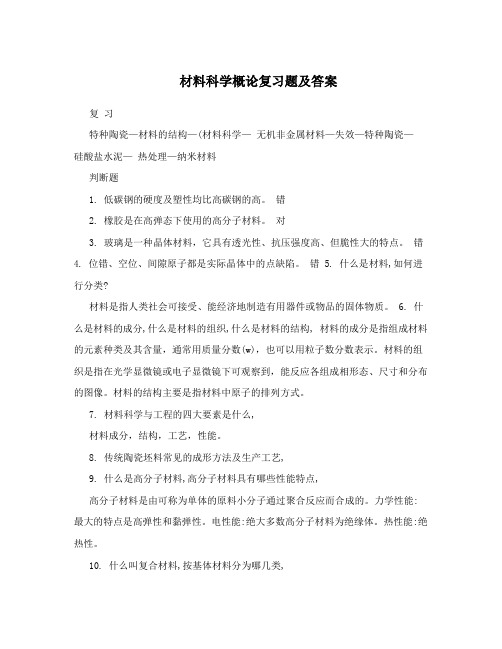
材料科学概论复习题及答案复习特种陶瓷—材料的结构—(材料科学—无机非金属材料—失效—特种陶瓷—硅酸盐水泥—热处理—纳米材料判断题1. 低碳钢的硬度及塑性均比高碳钢的高。
错2. 橡胶是在高弹态下使用的高分子材料。
对3. 玻璃是一种晶体材料,它具有透光性、抗压强度高、但脆性大的特点。
错4. 位错、空位、间隙原子都是实际晶体中的点缺陷。
错5. 什么是材料,如何进行分类?材料是指人类社会可接受、能经济地制造有用器件或物品的固体物质。
6. 什么是材料的成分,什么是材料的组织,什么是材料的结构, 材料的成分是指组成材料的元素种类及其含量,通常用质量分数(w),也可以用粒子数分数表示。
材料的组织是指在光学显微镜或电子显微镜下可观察到,能反应各组成相形态、尺寸和分布的图像。
材料的结构主要是指材料中原子的排列方式。
7. 材料科学与工程的四大要素是什么,材料成分,结构,工艺,性能。
8. 传统陶瓷坯料常见的成形方法及生产工艺,9. 什么是高分子材料,高分子材料具有哪些性能特点,高分子材料是由可称为单体的原料小分子通过聚合反应而合成的。
力学性能:最大的特点是高弹性和黏弹性。
电性能:绝大多数高分子材料为绝缘体。
热性能:绝热性。
10. 什么叫复合材料,按基体材料分为哪几类,复合材料指由两种或更多种物理性能、化学性能、力学性能和加工性能不同的物质,经人工组合而成的多相固体材料。
复合材料可分为基体相和增强相。
按基体分为树脂基、金属基陶瓷基。
11. 陶瓷由哪些基本相组成,它们对陶瓷的性能有什么影响, 晶体相、玻璃相、气相。
12. 简述提高陶瓷材料强度及减轻脆性的途径,13. 按照用途可将合金钢分为哪几类,机器零部件用钢主要有哪些,可分为结构钢,工具钢,特殊钢和许多小类。
轴,齿轮,连接件。
14. 材料典型的热处理工艺有哪些,什么叫回火?退火、正火、淬火、回火。
钢件淬火后,为了消除内应力并获得所要求的性能,将其加热Ac1以下的某一温度,保温一定时间,然后冷却到室温的热处理工艺叫做回火。
材料概论期末考试题及答案
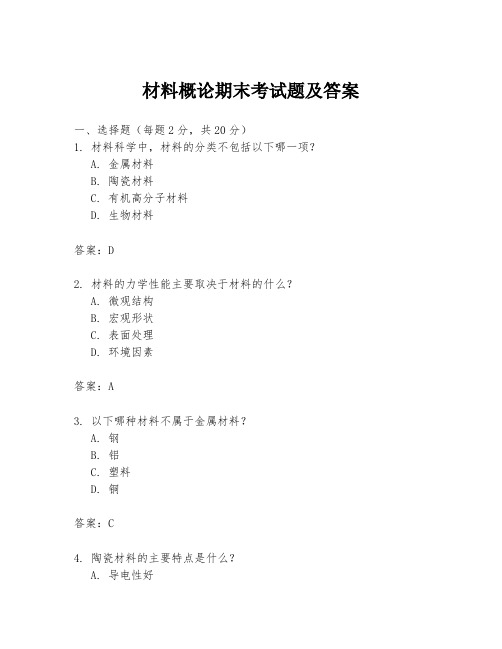
材料概论期末考试题及答案一、选择题(每题2分,共20分)1. 材料科学中,材料的分类不包括以下哪一项?A. 金属材料B. 陶瓷材料C. 有机高分子材料D. 生物材料答案:D2. 材料的力学性能主要取决于材料的什么?A. 微观结构B. 宏观形状C. 表面处理D. 环境因素答案:A3. 以下哪种材料不属于金属材料?A. 钢B. 铝C. 塑料D. 铜答案:C4. 陶瓷材料的主要特点是什么?A. 导电性好B. 导热性好C. 耐腐蚀D. 弹性好答案:C5. 有机高分子材料的分子结构通常是什么?A. 线型结构B. 网状结构C. 层状结构D. 纤维结构答案:A6. 材料的热处理过程通常不包括以下哪一项?A. 退火B. 正火C. 淬火D. 焊接答案:D7. 材料的硬度是指材料的什么性质?A. 弹性B. 塑性C. 韧性D. 抗磨损能力答案:D8. 金属材料的塑性变形通常发生在哪个温度区间?A. 室温B. 低温C. 高温D. 熔点附近答案:A9. 材料的疲劳寿命与什么因素有关?A. 材料的强度B. 材料的硬度C. 材料的韧性D. 所有上述因素答案:D10. 材料的断裂韧性是指材料在什么条件下的性能?A. 静载荷作用下B. 动载荷作用下C. 冲击载荷作用下D. 循环载荷作用下答案:D二、简答题(每题5分,共30分)1. 简述材料的热处理对材料性能的影响。
答案:材料的热处理是通过对材料进行加热、保温和冷却等过程来改变材料的微观结构,从而改善材料的宏观性能。
例如,退火可以降低材料的硬度,提高韧性;淬火可以提高材料的硬度和强度;正火可以消除材料的内应力,改善材料的塑性。
2. 什么是材料的疲劳寿命?影响疲劳寿命的因素有哪些?答案:材料的疲劳寿命是指材料在循环载荷作用下,从开始加载到发生疲劳断裂的时间。
影响疲劳寿命的因素包括材料的微观结构、材料的化学成分、载荷的大小和频率、环境因素等。
3. 什么是材料的断裂韧性?断裂韧性与材料的哪些性质有关?答案:材料的断裂韧性是指材料在受到冲击载荷作用下,抵抗裂纹扩展的能力。
材料概论练习题答案 1

材料概论练习题答案 1材料概论练习题答案-1介绍1.什么是材料?答:材料由若干相互作用的元素按一定比例组成,具有一定的结构水平和一定的性能,可用于制造商品、装置、部件、机器或其他产品。
2.人类文明史与材料发展之间的关系?答:材料是人类文明的里程碑;材料是人类赖以生存和发展的重要物质基础;人类的历史曾以使用的主要材料来加以划分。
3.根据成分和结构特征,可以划分哪些类型的材料?无机非金属材料水泥、陶瓷、玻璃、耐火材料金属材料黑色、有色、特殊金属材料、聚合物材料塑料、橡胶、纤维、涂料、粘合剂复合材料金属基、陶瓷基、树脂基、碳-碳材料4材料科学和工程的概念?答:材料科学与工程是关于材料成分、结构、工艺和它们性能与应用之间有关知识开发和应用的科学。
它是一个多学科的交叉领域,是从科学到工程的一个专业连续领域。
同时材料科学与工程学科以数学、力学及物理、化学自然科学为基础,以工程学科为服务和支撑对象,是一个理工结合、多学科交叉的新兴学科,其研究领域涉及自然科学、应用科学和工程学。
5.日本专家岛村昭治将材料的发展历史划分为哪五代?答:旧石器时代新石器时代青铜器时代铁器时代高分子材料和硅材料的时代第2章MSE的四个基本要素1.材料科学与工程的四个要素是什么?答:成分、结构、合成和加工、性质/性能2.什么是材料的化学组成?相的概念?材料相的组成?答:材料的化学成分:构成材料的最基本、最独立的物质可以是纯元素或稳定的化合物,以及它们的类型和数量;相:材料中具有相同化学成分和相同结构的均匀部分称为相;组成材料的相的类型和数量称为相组成3材料的结构是什么?答:材料的结构是指材料的组元及其排列和运动方式。
包含形貌、化学成分、相组成、晶体结构和缺陷等内涵。
材料的结构决定材料的性能4.材料的合成的概念?材料加工的概念?答:合成:通常指用物理和化学方法将原子和分子结合起来制造新材料。
合成是发现固体中新的化学和物理现象的主要来源。
加工:这里所指的是成型加工,除了上述为生产出有用材料对原子和分子控制外,还包括在较大尺度上的改变,有时也包括材料制造等工程方面的问题合成与加工是指建立原子、分子和分子聚集体的新排列,在从原子尺度到宏观尺度的所有尺度上对结构进行控制以及高效而有竞争力地制造材料和零件的演变过程5.材料的性能、材料的功能以及材料使用性能的含义?答:材料性能:合成和加工是指建立原子、分子和分子聚集体的新排列,从原子尺度到宏观尺度的所有尺度上的结构控制,以及高效、有竞争力地制造材料和零件的进化过程;材料的功能:指当一种材料(材料)对应于一个输入信号,或其中一些材料将产生一定的输出,即可以产生另一种效果时,质量或数量的变化。
材料学概论试题
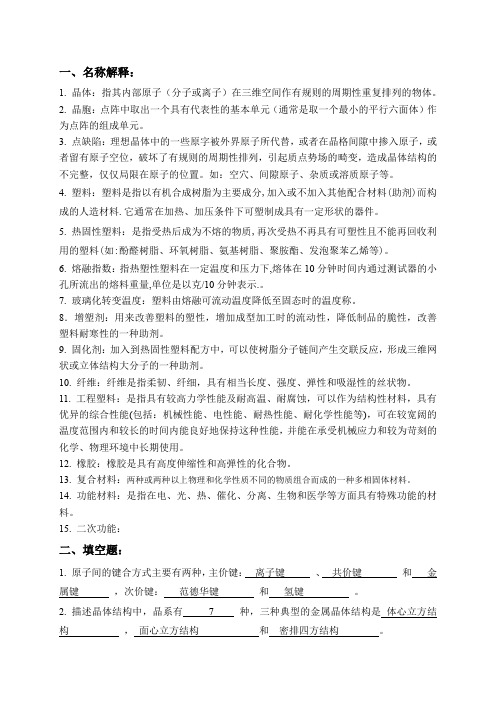
一、名称解释:1. 晶体:指其内部原子(分子或离子)在三维空间作有规则的周期性重复排列的物体。
2. 晶胞:点阵中取出一个具有代表性的基本单元(通常是取一个最小的平行六面体)作为点阵的组成单元。
3. 点缺陷:理想晶体中的一些原字被外界原子所代替,或者在晶格间隙中掺入原子,或者留有原子空位,破坏了有规则的周期性排列,引起质点势场的畸变,造成晶体结构的不完整,仅仅局限在原子的位置。
如:空穴、间隙原子、杂质或溶质原子等。
4. 塑料:塑料是指以有机合成树脂为主要成分,加入或不加入其他配合材料(助剂)而构成的人造材料.它通常在加热、加压条件下可塑制成具有一定形状的器件。
5. 热固性塑料:是指受热后成为不熔的物质,再次受热不再具有可塑性且不能再回收利用的塑料(如:酚醛树脂、环氧树脂、氨基树脂、聚胺酯、发泡聚苯乙烯等)。
6. 熔融指数:指热塑性塑料在一定温度和压力下,熔体在10分钟时间内通过测试器的小孔所流出的熔料重量,单位是以克/10分钟表示.。
7. 玻璃化转变温度:塑料由熔融可流动温度降低至固态时的温度称。
8.增塑剂:用来改善塑料的塑性,增加成型加工时的流动性,降低制品的脆性,改善塑料耐寒性的一种助剂。
9. 固化剂:加入到热固性塑料配方中,可以使树脂分子链间产生交联反应,形成三维网状或立体结构大分子的一种助剂。
10. 纤维:纤维是指柔韧、纤细,具有相当长度、强度、弹性和吸湿性的丝状物。
11. 工程塑料:是指具有较高力学性能及耐高温、耐腐蚀,可以作为结构性材料,具有优异的综合性能(包括:机械性能、电性能、耐热性能、耐化学性能等),可在较宽阔的温度范围内和较长的时间内能良好地保持这种性能,并能在承受机械应力和较为苛刻的化学、物理环境中长期使用。
12. 橡胶:橡胶是具有高度伸缩性和高弹性的化合物。
13. 复合材料:两种或两种以上物理和化学性质不同的物质组合而成的一种多相固体材料。
14. 功能材料:是指在电、光、热、催化、分离、生物和医学等方面具有特殊功能的材料。
材料概论复习题及答案

材料概论复习题及答案一、选择题(每题2分,共20分)1. 材料科学中,下列哪一项不是材料的基本性能?A. 力学性能B. 热学性能C. 光学性能D. 经济性能答案:D2. 材料的微观结构对其宏观性能的影响主要体现在哪些方面?A. 力学性能B. 热学性能C. 电学性能D. 所有以上选项答案:D3. 以下哪种材料不属于金属材料?A. 钢铁B. 铝合金C. 陶瓷D. 铜合金答案:C4. 材料的断裂韧性通常用来描述材料的哪种特性?A. 硬度B. 韧性C. 脆性D. 弹性答案:B5. 材料的疲劳寿命主要受哪些因素的影响?A. 材料的强度B. 材料的硬度C. 应力集中D. 所有以上选项答案:D6. 材料的热处理过程中,淬火的主要目的是?A. 提高硬度B. 提高韧性C. 提高耐腐蚀性D. 提高导电性答案:A7. 以下哪种材料具有最好的导电性能?A. 塑料B. 橡胶C. 玻璃D. 银答案:D8. 材料的塑性变形通常发生在哪个温度区间?A. 低于玻璃化转变温度B. 在玻璃化转变温度附近C. 高于玻璃化转变温度D. 以上都不对答案:C9. 材料的断裂模式主要分为哪两种?A. 拉伸断裂和压缩断裂B. 剪切断裂和拉伸断裂C. 脆性断裂和韧性断裂D. 疲劳断裂和蠕变断裂答案:C10. 材料的硬度通常通过哪种测试来测量?A. 拉伸测试B. 压缩测试C. 硬度测试D. 冲击测试答案:C二、填空题(每空1分,共20分)1. 材料的_______性能是指材料在受到外力作用时,抵抗变形和破坏的能力。
答案:力学2. 材料的热膨胀系数是指材料在单位温度变化下长度变化的_______。
答案:比例3. 金属材料的强化机制主要包括_______强化、_______强化和_______强化。
答案:固溶,加工,沉淀4. 陶瓷材料的主要特点是_______、_______和_______。
答案:高硬度,高熔点,低热导率5. 聚合物材料的玻璃化转变温度是指聚合物从_______状态转变为_______状态的温度。
材料概论模拟试题两套
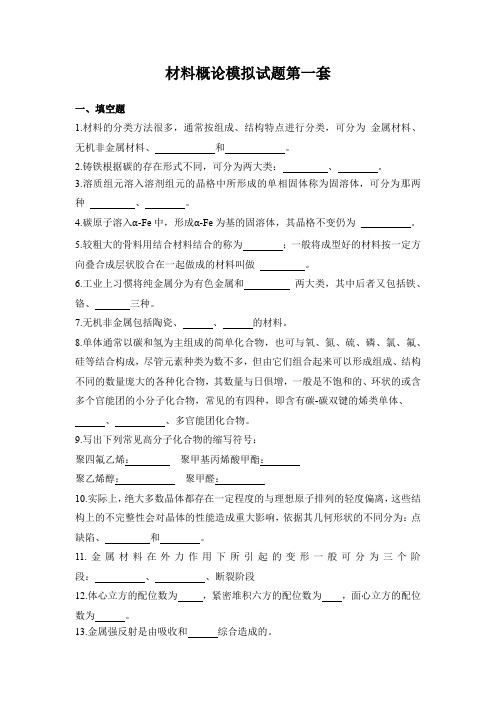
材料概论模拟试题第一套一、填空题1.材料的分类方法很多,通常按组成、结构特点进行分类,可分为金属材料、无机非金属材料、和。
2.铸铁根据碳的存在形式不同,可分为两大类:、。
3.溶质组元溶入溶剂组元的晶格中所形成的单相固体称为固溶体,可分为那两种、。
4.碳原子溶入α-Fe中,形成α-Fe为基的固溶体,其晶格不变仍为。
5.较粗大的骨料用结合材料结合的称为;一般将成型好的材料按一定方向叠合成层状胶合在一起做成的材料叫做。
6.工业上习惯将纯金属分为有色金属和两大类,其中后者又包括铁、铬、三种。
7.无机非金属包括陶瓷、、的材料。
8.单体通常以碳和氢为主组成的简单化合物,也可与氧、氮、硫、磷、氯、氟、硅等结合构成,尽管元素种类为数不多,但由它们组合起来可以形成组成、结构不同的数量庞大的各种化合物,其数量与日俱增,一般是不饱和的、环状的或含多个官能团的小分子化合物,常见的有四种,即含有碳-碳双键的烯类单体、、、多官能团化合物。
9.写出下列常见高分子化合物的缩写符号:聚四氟乙烯:聚甲基丙烯酸甲酯:聚乙烯醇:聚甲醛:10.实际上,绝大多数晶体都存在一定程度的与理想原子排列的轻度偏离,这些结构上的不完整性会对晶体的性能造成重大影响,依据其几何形状的不同分为:点缺陷、和。
11.金属材料在外力作用下所引起的变形一般可分为三个阶段:、、断裂阶段12.体心立方的配位数为,紧密堆积六方的配位数为,面心立方的配位数为。
13.金属强反射是由吸收和综合造成的。
14.金属腐蚀是一种常见的现象,导致腐蚀的基本原因可分为和两种。
15.以平板玻璃熔制为例将玻璃的熔置分为五个阶段:硅酸盐的形成阶段、玻璃液形成阶段、、玻璃液均化阶段、玻璃液冷却阶段。
16. 常用的选矿方法有重选法、浮选法和。
二、简答题1、简述材料的五大特性以及材料的发展趋势2、何为材料的力学强度?影响力学强度的主要因素有哪些?按作用力的方式不同,材料的力学强度可分为哪几种强度?3、石英、长石、高岭土三组分常被用来制备长石制瓷,长石制瓷是陶瓷的一种,请分阶段简述陶瓷的烧成过程三、判断题(正确的在括号内填T,错误的填F)1.共价键是化学键中最简单的类型。
材料概论作业题和答案1

材料概论作业题和答案11什么是材料科学与工程?材料科学与工程的四要素是什么?材料科学与工程是研究材料组成、结构、生产过程材料性能与使用效能以及它们之间的关系。
2材料科学与工程的四个基本要素:组成与结构、合成与生产过程、性质及使用效能。
1、简述晶体的定义和特点?晶体是指其内部粒子呈规则排列的物质。
晶体的特点:一般具有规则的外形;有固定的熔点;各向异性。
2、简述金属中常见的三种晶体结构及每种结构的特点?体心立方晶格:体心立方晶格的晶胞是由八个原子构成的立方体,并且在立方体的体中心还有一个原子,晶格常数a=b=c,通常只用a 表示。
每个体心立方晶胞中仅含有8×1/8+1=2个原子。
面心立方晶格:面心立方晶格的晶胞也是由八个原子构成的立方体,但在立方体的每个面上还各有一个原子。
晶格常数a=b=c,通常只用a表示。
晶胞中包含有8×1/8+6×1/2=4个原子。
密排六方晶格:密排六方晶格由12个原子构成的简单六方晶体,且在上下两个六方面心还各有一个原子,而且简单六方体中心还有3个原子。
晶格常数a=b≠c,c/a=1.633。
晶胞中所含原子数6×1/6×2+2×1/2+3=6个原子。
3、金属变形有哪几个阶段?金属塑性变形对其组织和性能有何影响?金属变形的三个阶段:弹性变形,塑性变形,断裂三个阶段。
影响:(1)塑性变形对金属性能的影响:产生加工硬化。
(2)塑性变形对金属组织的影响:形成纤维状组织、形成亚结构、产生形变织构。
(3)使金属晶体缺陷增多,并产生残余应力。
残余应力的存在会导致材料及工件产生变形、开裂、耐蚀性下降等有害影响。
4、简述碳钢的牌号与用途。
(1)普通碳素结构钢:Q195、Q215、Q235、Q255、Q275等。
数字表示最低屈服强度。
Q195、Q215、Q235塑性好,可轧制成钢板、钢筋、钢管等。
Q255、Q275可轧制成型钢、钢板等。
材料概论考试试题

材料概论考试试题材料概论考试试题材料概论是一门涉及材料科学与工程的基础课程,旨在培养学生对材料的基本认识和理解。
考试是对学生对材料概论知识的掌握程度进行评估的重要方式之一。
下面我们来看一下一份典型的材料概论考试试题。
第一部分:选择题1. 材料的分类主要依据的是:A. 材料的形状B. 材料的成分C. 材料的价格D. 材料的颜色2. 下列哪种材料是金属?A. 木材B. 纺织品C. 玻璃D. 铝合金3. 材料的力学性能主要包括下列哪几个方面?A. 密度和热导率B. 强度和韧性C. 导电性和导热性D. 耐腐蚀性和耐磨性第二部分:填空题1. 水的化学式是______。
2. 钢的主要成分是______。
3. 塑料的主要原料是______。
第三部分:简答题1. 请简要介绍一下材料的结构层次。
2. 什么是材料的晶体结构?请举例说明。
3. 请解释一下材料的力学性能中的强度和韧性的概念。
第四部分:分析题某种材料的密度为2.7 g/cm³,熔点为1538°C,抗拉强度为300 MPa,屈服强度为250 MPa,断裂韧性为40 J/m²。
请回答以下问题:1. 该材料属于什么类别的材料?2. 该材料的熔点属于高熔点材料还是低熔点材料?3. 该材料的强度和韧性如何?请对比其他材料进行分析。
第五部分:应用题某汽车零部件需要具备一定的强度和韧性,并且要求耐腐蚀。
请根据这些要求,选择适合的材料,并简要说明选择的理由。
总结:材料概论考试试题旨在评估学生对材料概论知识的掌握程度。
通过选择题、填空题、简答题、分析题和应用题等多种形式的问题,考察学生对材料分类、力学性能、结构层次等方面的理解和应用能力。
考试试题的设计既注重基础知识的掌握,又注重学生对材料的实际应用能力的培养。
通过这样的考试形式,可以全面评估学生的学习成果,为进一步的学习和研究提供基础。
青海大学《材料概论》真题库

第二章1、材料科学与工程的四个基本要素(材料的成分)、(组织结构)、(合成加工)、(性质与使用性能)。
2、材料的组织是指材料(内部)的微观形貌。
3、材料中原子、分子之间的结合键分为(化学键)和(物理键)两类。
其中化学键包括(离子键)、(共价键)、(金属键)。
物理键包括(分子键)、(氢键)。
4、固体物质按原子排列方式的不同以三种形式存在(晶体)、(非晶体)、(准晶体)。
5、化学键中的(离子键)和(金属键)没有方向性和饱和性。
6、金刚石为(原子)晶体。
7、简述晶体和非晶体的区别。
晶体是内部质点在三维空间成周期性重复排列的固体,具有长程有序,并成周期性重复排列.非晶体是内部质点在三维空间不成周期性重复排列的固体,具有近程有序,但不具有长程有序.8、分别将晶体、晶格、晶胞填入相对应的图形下面。
(晶体)(晶格)(晶胞)9、写出体心立方晶体结构的特征参量,并简述如何得到的。
晶胞原子数:2配位数:8致密度:68%p1410、晶体缺陷根据其几何形态特征分为:(点缺陷)、(线缺陷)、(面缺陷)。
11、天然矿物原料按工业用途的不同分为(金属矿物)、(非金属矿物)、(燃料矿)。
12、钛白粉属于氧化物无机化工原料中的(化工颜料)。
13、三大有机合成材料指的是(合成树脂)、(合成橡胶)、(合成纤维)。
14、材料的制备方法可分为(气相法)、(液相法)、(固相法)三大类。
15、溶胶-凝胶法属于(液相法)方法,其制备过程包括(溶液)、(溶胶)、(凝胶)、(材料)。
16、材料的成型特性主要表现为(可流动性)和(可塑性变形性)。
根据其特性可将成形方法分为(自由流动性)、(受力流动成型)、(受力塑性变形)和其他成形。
17、固体加热时有三个重要的热效应:(吸热)、(传热)、(膨胀)。
18、物质的介电强度(越大),它作为绝缘体的质量越好。
19、物质在磁场的作用下都会表现出一定的磁性。
按照对磁场的影响可将物质分为(抗磁性物质)、(顺磁性物质)、(铁磁性及亚铁磁性物质)。
材料科学与工程概论A卷参考答案及评分标准
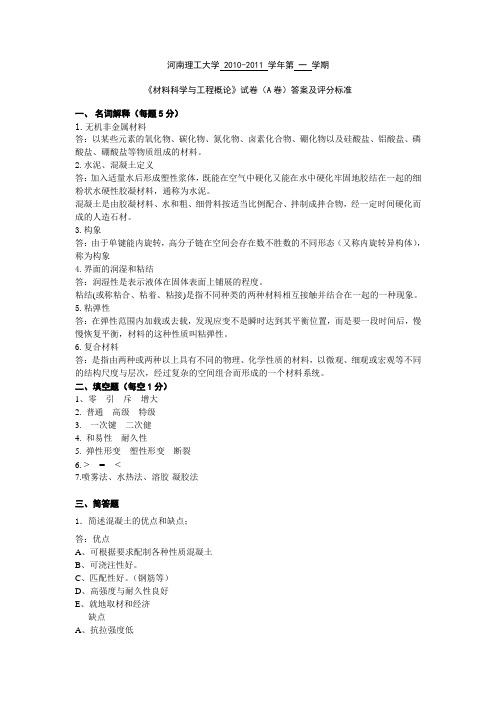
河南理工大学 2010-2011 学年第一学期《材料科学与工程概论》试卷(A卷)答案及评分标准一、名词解释(每题5分)1.无机非金属材料答:以某些元素的氧化物、碳化物、氮化物、卤素化合物、硼化物以及硅酸盐、铝酸盐、磷酸盐、硼酸盐等物质组成的材料。
2.水泥、混凝土定义答:加入适量水后形成塑性浆体,既能在空气中硬化又能在水中硬化牢固地胶结在一起的细粉状水硬性胶凝材料,通称为水泥。
混凝土是由胶凝材料、水和粗、细骨料按适当比例配合、拌制成拌合物,经一定时间硬化而成的人造石材。
3.构象答:由于单键能内旋转,高分子链在空间会存在数不胜数的不同形态(又称内旋转异构体),称为构象4.界面的润湿和粘结答:润湿性是表示液体在固体表面上铺展的程度。
粘结(或称粘合、粘着、粘接)是指不同种类的两种材料相互接触并结合在一起的一种现象。
5.粘弹性答:在弹性范围内加载或去载,发现应变不是瞬时达到其平衡位置,而是要一段时间后,慢慢恢复平衡,材料的这种性质叫粘弹性。
6.复合材料答:是指由两种或两种以上具有不同的物理、化学性质的材料,以微观、细观或宏观等不同的结构尺度与层次,经过复杂的空间组合而形成的一个材料系统。
二、填空题(每空1分)1、零引斥增大2. 普通高级特级3. 一次键二次健4. 和易性耐久性5. 弹性形变塑性形变断裂6. > = <7.喷雾法、水热法、溶胶-凝胶法三、简答题1.简述混凝土的优点和缺点;答:优点A、可根据要求配制各种性质混凝土B、可浇注性好。
C、匹配性好。
(钢筋等)D、高强度与耐久性良好E、就地取材和经济缺点A、抗拉强度低B 、变形能力小C 、容易开裂D 、自重大2.请简述晶胞选取应满足的条件答:(1)晶胞的几何形状充分反映点阵的对称性;(2)平行六面体内相等的棱和角数目最多;(3)当棱间呈直角时,直角数目应最多;(4)晶胞体积应最小。
3.影响材料断裂的因素有哪些?答:①结合键及晶体结构类型的决定性影响;②材料的化学成分及显微组织的重要影响;③裂纹及应力状态的影响;④温度对材料断裂行为的影响。
材料学概论试题及答案

材料学概论试题及答案一、单项选择题(每题2分,共20分)1. 材料科学中,下列哪一项不是材料的基本特性?A. 力学性能B. 热学性能C. 光学性能D. 化学活性答案:D2. 金属的塑性变形主要通过哪种机制?A. 位错运动B. 相变C. 扩散D. 断裂答案:A3. 陶瓷材料的脆性主要与下列哪种因素有关?A. 晶体结构B. 表面缺陷C. 温度D. 化学成分答案:B4. 下列哪种材料不是复合材料?A. 碳纤维增强塑料B. 钢筋混凝土C. 不锈钢D. 玻璃钢5. 玻璃的主要成分是?A. 二氧化硅B. 氧化铝C. 氧化钙D. 氧化镁答案:A6. 金属材料的硬度通常与下列哪种因素有关?A. 晶体结构B. 晶粒大小C. 合金元素D. 所有以上因素答案:D7. 哪种金属具有最高的熔点?A. 钨B. 铁C. 铜D. 铝答案:A8. 材料的疲劳是指?A. 材料在循环应力作用下的断裂B. 材料在恒定应力作用下的断裂C. 材料在高温下的氧化D. 材料在腐蚀环境下的腐蚀答案:A9. 哪种材料的导热性能最好?B. 陶瓷C. 塑料D. 木材答案:A10. 下列哪种材料的耐腐蚀性最好?A. 不锈钢B. 碳钢C. 铝合金D. 铜合金答案:A二、多项选择题(每题3分,共15分)1. 下列哪些因素会影响材料的力学性能?A. 微观结构B. 加工工艺C. 温度D. 化学成分答案:ABCD2. 材料的热处理可以改变哪些特性?A. 硬度B. 韧性C. 导电性D. 耐腐蚀性答案:ABD3. 下列哪些是金属材料的常见合金元素?A. 碳B. 硅D. 氧答案:AB4. 材料的断裂韧性与哪些因素有关?A. 材料的微观结构B. 材料的硬度C. 材料的厚度D. 断裂前的应力答案:ABD5. 下列哪些是常见的高分子材料?A. 聚乙烯B. 聚氯乙烯C. 聚丙烯D. 聚酯答案:ABCD三、简答题(每题5分,共20分)1. 简述材料的疲劳破坏过程。
答案:材料的疲劳破坏过程是指在循环应力作用下,材料内部的缺陷逐渐扩展,最终导致材料断裂的过程。
大一材料概论考试题及答案
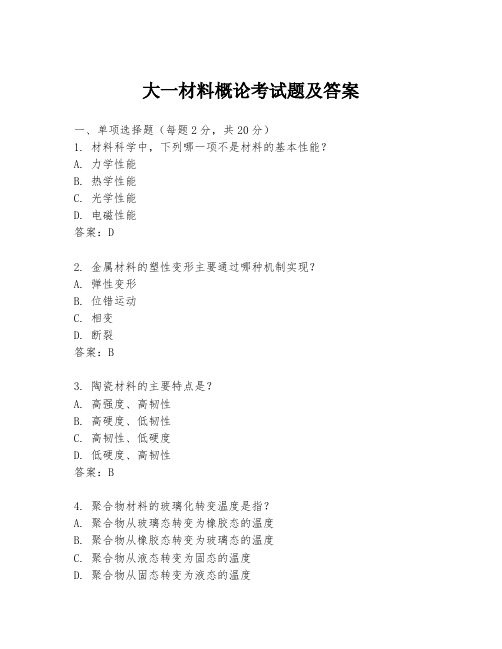
大一材料概论考试题及答案一、单项选择题(每题2分,共20分)1. 材料科学中,下列哪一项不是材料的基本性能?A. 力学性能B. 热学性能C. 光学性能D. 电磁性能答案:D2. 金属材料的塑性变形主要通过哪种机制实现?A. 弹性变形B. 位错运动C. 相变D. 断裂答案:B3. 陶瓷材料的主要特点是?A. 高强度、高韧性B. 高硬度、低韧性C. 高韧性、低硬度D. 低硬度、高韧性答案:B4. 聚合物材料的玻璃化转变温度是指?A. 聚合物从玻璃态转变为橡胶态的温度B. 聚合物从橡胶态转变为玻璃态的温度C. 聚合物从液态转变为固态的温度D. 聚合物从固态转变为液态的温度答案:A5. 以下哪种材料不属于复合材料?A. 玻璃钢B. 碳纤维增强塑料C. 铝合金D. 钛合金答案:D6. 金属材料的热处理过程中,淬火的主要目的是?A. 提高硬度B. 增加韧性C. 减少塑性D. 改善耐腐蚀性答案:A7. 材料的疲劳是指在循环载荷作用下材料的?A. 塑性变形B. 断裂C. 磨损D. 腐蚀答案:B8. 材料的断裂韧性是指材料在断裂前吸收能量的能力,通常用哪个参数表示?A. 应力B. 应变C. 硬度D. 韧性答案:D9. 材料的蠕变是指在恒定应力作用下材料发生的?A. 弹性变形B. 塑性变形C. 断裂D. 相变答案:B10. 材料的硬度通常是指材料的?A. 抗拉强度B. 抗压强度C. 抗剪强度D. 抗磨损能力答案:D二、填空题(每题2分,共20分)1. 材料的弹性模量是指材料在__________下应力与应变的比值。
答案:弹性变形2. 金属材料的疲劳寿命与__________有关。
答案:循环载荷的频率和应力幅值3. 材料的断裂韧性KIC的单位是__________。
答案:MPa√m4. 材料的热膨胀系数是指单位温度变化下材料长度的__________。
答案:相对变化5. 材料的导热系数是指单位时间内通过单位面积的材料,单位温差下的热量。
材料学概论考研试题及答案

材料学概论考研试题及答案试题:一、单项选择题(每题2分,共10分)1. 材料科学中的“相”是指:A. 物质的宏观形态B. 物质的微观结构C. 物质的化学成分D. 物质的物理状态2. 下列哪项不是金属材料的强化机制?A. 固溶强化B. 形变强化C. 相界强化D. 腐蚀强化3. 陶瓷材料的主要特点是:A. 高强度和高韧性B. 高硬度和低密度C. 高导电性和高热导率D. 低强度和高塑性4. 下列关于合金的说法错误的是:A. 合金的熔点通常低于其组成金属的熔点A. 合金的硬度通常高于其组成金属的硬度C. 合金的耐腐蚀性通常高于其组成金属的耐腐蚀性D. 合金的导电性通常低于其组成金属的导电性5. 聚合物的玻璃化转变温度(Tg)是指:A. 聚合物从橡胶态转变为玻璃态的温度B. 聚合物从玻璃态转变为橡胶态的温度C. 聚合物从液态转变为固态的温度D. 聚合物从固态转变为液态的温度二、简答题(每题10分,共20分)1. 简述金属的疲劳现象及其影响因素。
2. 描述一下什么是纳米材料,并说明其独特的物理性能。
三、计算题(每题15分,共30分)1. 一块合金的质量为100克,其中含有20克的铝和30克的铜。
如果合金的密度为2.8g/cm³,求合金的体积。
2. 一个立方体形状的钢材,其边长为0.1米,若钢材的杨氏模量为200 GPa,求该立方体钢材在受到100 N的拉伸力作用下,其长度的相对变化量。
四、论述题(每题20分,共20分)1. 论述材料的断裂韧性与其微观结构之间的关系。
答案:一、单项选择题1. B2. D3. B4. D5. B二、简答题1. 金属的疲劳现象是指在低于材料屈服强度的循环应力作用下,材料发生逐渐的损伤累积,最终导致断裂的现象。
影响疲劳的因素包括应力集中、材料的微观结构、表面处理、环境因素等。
2. 纳米材料是指至少在一个维度上具有纳米级尺寸的材料。
由于其独特的尺寸效应、表面效应和量子效应,纳米材料展现出许多特殊的物理性能,如高强度、高热导率、高电导率以及特殊的光学和磁学性质。
材料概论练习题答案

材料概论练习题答案(总6页)--本页仅作为文档封面,使用时请直接删除即可----内页可以根据需求调整合适字体及大小--(—)填空题1、机械设计常用屈服强度和抗拉强度两种强度指标。
2、设计刚度好的零件,应根据刚度指标来选择材料。
3、T K是材料从韧性状态转变为脆性状态时的温度。
4、冲击韧性的单位是 J/cm2;延伸率的单位是 % ;屈服强度的单位是 MPa或N/mm2。
5、屈强比是屈服强度与抗拉强度之比。
6、材料主要的工艺性能有铸造性能、锻造性能、焊接性能、和切屑性能。
7、热敏电阻陶瓷可分为正温度系数(PTC)热敏陶瓷、负温度系数(NTC)热敏陶瓷和临界温度系数(CTR)热敏陶瓷。
8、无机胶凝材料可分为气硬性无机胶凝材料和水硬性无机胶凝材料。
9、石灰硬化包括干燥、结晶和碳化三个过程。
10、石膏可分为二水石膏、半水石膏、可熔石膏和无水石膏四大类。
11、水硬性无机胶凝材料是指既能在空气中硬化又能在水中硬化的材料。
12、水泥按用途和性能可分为通用水泥、专用水泥、特性水泥三大类。
13、能产生激光的固体材料都是由(基质晶体)和(激活离子)两部分组成。
实际上掺杂离子就是(激活离子)14、铁氧体是作为(高频用磁性材料)而制备的金属氧化物烧结磁性体,它分为(软磁铁氧体)和(硬磁铁氧体)。
15、表征压电材料的参数是(机电耦合系数K)(K=通过压电效应转换的电能/输入的机械能),K值恒小于1,它是压电材料进行(机—电能量转换)的能力反映。
16、在三价稀土氧化物中掺入二价阳离子将产生(O2-空位),若掺入四价阳离子会产生(间隙氧离子),从而改变三价稀土氧化物的导电性。
17、判断材料是否具有超导性,有两个基本特征:一是(超导电性),二是(完全抗磁性)。
18、陶瓷材料的性能:具有(高熔点)、(高硬度)、高化学稳定性、耐高温、耐磨、耐氧化、耐腐蚀、(弹性模量大)等特点,但(塑性)、(韧性)、可加工性、抗热震性、使用可靠性不如金属材料。
材料概论试题

1.何为材料,为何材料是人类社会生活的物质基础?材料是人类用于制造物品、器件或其他产品的物质。
是人类要生存需要的最基本的物质生活资料。
物质生产活动是人类从事其他各种社会活动的先决条件。
2.材料科学与工程的四个基本要素是什么?请说明他们之间的关系。
材料的四个基本要素:结构与成分、性质、合成与制备、用途与性能3.复合材料设计的基本思想是什么?举一例说明。
达到功能复合,能保留原组成原料的特性,并通过复合效应得到原来所不具有的更为优越的新性能。
碳纤维复合材料制造大飞机;轮胎是由橡胶、碳黑、帘子线等材料构成的。
4.从燕子造窝到人用草拌泥造房、再到我们用碳纤维复合材料制造大飞机的过程,你得到了哪些启示?这些复合材料的制备都还停留在经验的层面上,而碳纤维复合材料制造大飞机虽然使用了一贯的复合思想,但相比之下更具有系统性、科学性。
如今我们创造新的复合材料不再需要像过去一样完全依靠试错法,而有相关的理论指导,所以我们在探索新领域时可以从一些已有的思想中获取灵感,再用理论化地手段将其转化为材料科学。
5.绿色建筑的基本涵义?绿色建筑指在建筑的全寿命周期内,最大限度地节约资源,保护环境和减少污染,为人们提供健康、舒适和高效的使用空间,与自然和谐共生的建筑物。
6.建筑生态环境材料的基本涵义?生态环境材料是指那些具有良好的使用性能和优良的环境协调性的材料7.看《终结者2》推测那个人材料的性能与特点,并推测由什么方法合成。
(描述电影中未来人材料的特点和性能,并设想可由什么方式合成?终结者2中的机器人由液态金属构成,具有流动性和高强度性,韧性好,可再组合。
合成方法:合金合成法,置于电解液中的镓基液态合金在和铝合金结合后,能长期高速运转。
8.试说明金属材料在民航飞机中的应用情况铝合金用作承力件,钛合金用于具有一定耐热性和耐腐蚀性的板材结构件,高强度结构钢,用于前后起落架;不锈钢,用于发动机的一些装置。
高温合金用于耐高温的板材结构件和螺栓,螺母等固件和排气孔的蜂窝结构9.说明燃料电池的工作原理及其特点。
材料导论试题及答案
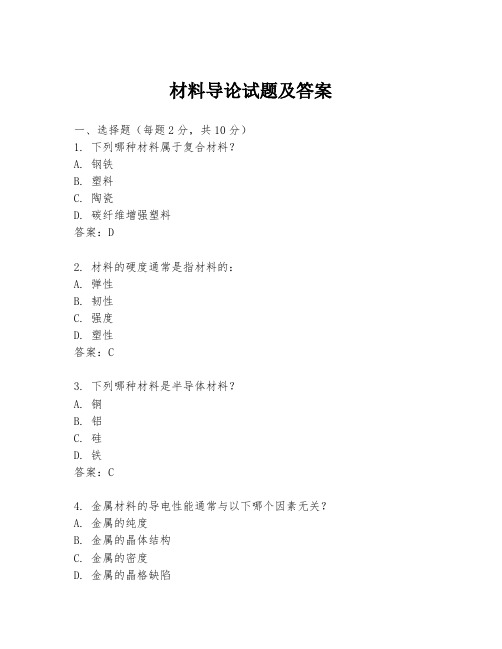
材料导论试题及答案一、选择题(每题2分,共10分)1. 下列哪种材料属于复合材料?A. 钢铁B. 塑料C. 陶瓷D. 碳纤维增强塑料答案:D2. 材料的硬度通常是指材料的:A. 弹性B. 韧性C. 强度D. 塑性答案:C3. 下列哪种材料是半导体材料?A. 铜B. 铝C. 硅D. 铁答案:C4. 金属材料的导电性能通常与以下哪个因素无关?A. 金属的纯度B. 金属的晶体结构C. 金属的密度D. 金属的晶格缺陷答案:C5. 陶瓷材料的主要优点是:A. 良好的导电性B. 良好的导热性C. 良好的绝缘性D. 良好的延展性答案:C二、填空题(每题2分,共10分)1. 材料的________是指材料在受到外力作用时抵抗变形的能力。
答案:弹性2. 材料的________是指材料在受到外力作用时抵抗断裂的能力。
答案:韧性3. 材料的________是指材料在受到外力作用时抵抗永久变形的能力。
答案:强度4. 材料的________是指材料在受到外力作用时抵抗塑性变形的能力。
答案:硬度5. 材料的________是指材料在受到外力作用时抵抗压缩变形的能力。
答案:抗压强度三、简答题(每题5分,共20分)1. 简述金属材料的热处理过程。
答案:金属材料的热处理过程通常包括加热、保温和冷却三个阶段。
加热阶段使材料达到一定温度,保温阶段使材料内部结构发生变化,冷却阶段则使材料获得所需的组织和性能。
2. 什么是材料的疲劳强度?其影响因素有哪些?答案:材料的疲劳强度是指材料在重复或循环载荷作用下,经过一定次数的应力循环后发生断裂的最大应力值。
影响疲劳强度的因素包括材料的微观结构、表面状态、应力集中、温度以及载荷循环的频率等。
3. 请解释什么是材料的热膨胀系数。
答案:热膨胀系数是指材料在温度变化时,单位长度或单位体积的线性或体积变化量与温度变化量的比值。
它是衡量材料热膨胀性能的一个重要参数。
4. 简述塑料材料的加工方法有哪些。
答案:塑料材料的加工方法主要包括挤出成型、注射成型、吹塑成型、压缩成型、热成型等。
- 1、下载文档前请自行甄别文档内容的完整性,平台不提供额外的编辑、内容补充、找答案等附加服务。
- 2、"仅部分预览"的文档,不可在线预览部分如存在完整性等问题,可反馈申请退款(可完整预览的文档不适用该条件!)。
- 3、如文档侵犯您的权益,请联系客服反馈,我们会尽快为您处理(人工客服工作时间:9:00-18:30)。
第 1 页共3 页
3.工具钢具有独特的性能,如高温稳定性,耐磨耗性,机械加工性,
和韧性。
大多数工具钢是易碎的,除非经过特殊处理,以增加其韧性。
工具钢这样的性质允许它们作为用于切分和成型的金属和其他材料的热和冷的工具的使用。
应用集中于四个基本类别:耐冲击,热加工,冷加工,和高速。
4. 通常,我们将材料分为三大类,金属及其合金、高分子材料与陶瓷。
这种分类方法的依据是材料的原子结构及其化学键类型。
其中,金属及其合金通常是良好的导电、导热材料,且多数金属及其合金坚硬、熔点高并能承受一定的塑性变形。
4.Typically, we will be divided into three categories materials, metals and alloys, polymers and ceramics. This classification is based on the atomic structure and chemical bonding types of materials. Among them, the metal and its alloys are usually good electrical conductivity, thermal conductivity material, and most of the metal and its alloys hard, high melting point and can withstand a certain degree of plastic deformation.
5. 自然界中的固态材料可分为晶态(crystalline)材料与非晶态材料(amorphous),二者性能不同。
晶态材料加热时保持固态直至某一温度熔化变为液态;非晶态材料加热时在一个较宽的温度范围内逐渐软化,最终变为液态。
5. The nature of the solid materials can be divided into crystalline (crystalline) material with amorphous material (amorphous), the performance difference between the two. Crystalline material remains heated until a temperature of melting the solid state to a liquid state; softens gradually over a wide temperature range when the amorphous material is heated, and ultimately into a liquid.
6.铸铁本质上是铁、碳和硅(silicon)的合金,其成分是铁、2%-6.67%的碳以及少量的锰(manganese)、硫(sulfur)和磷(phosphorus)。
由于脆性过高而无法以其它方法成形,铸铁一般用铸型(mold)铸造成型。
其脆性是由高的含碳量引起的,而高的含碳量同时也提高了铸铁的强度。
6.Iron, carbon and silicon (silicon) alloy is essentially iron, which component is iron, 2% -6.67% of carbon and small amounts of manganese (manganese), sulfur (sulfur) and P (phosphorus). Due to the high brittleness and can not be otherwise shaped, usually with iron mold (mold) casting. Brittleness is caused by the high carbon content, and high carbon content also improves the strength of cast iron.
三、识图并选择与图示对应的说明(每空2分,共14分)
1. 2. 3.4.
5.
6.
第 2 页共3 页
图Aluminum production process
A.Alumina precipitate B. Dryer C. Impurities filtered out
D. Crushed and washed
E. Aluminum ingots
F. Bauxite ore
G. Mixed with lime and soda ash
四、根据句子意思选择合适的词语(每空1分,共10分)
1. When steel is cast into , the size of the products that can be made from the ingot is limited. Realizing this, a process has been developed, which removes the size restriction on the ingots.
2. Limestone(石灰石)is used as a blast furnace to remove such as sulfur and silica.
3. contains too much carbon and too many impurities to be used directly in most applications. It must be converted to in one of several types of converters.
4. Low alloy steels are steels with varying contents up to about 1% and with total contents below 5%.
5. As with other steels, stainless steel may be or cast. Wrought stainless steel is grouped by its structure as ferritic, , austenitic, and PH.
A. slag
B. martensitic
C. ingots
D. wrought
E. steel
F. Pig iron
G. alloy
H. carbon
I. impurities
J. continuous-pour
五、短文翻译(20分)
Forging consists of deforming steel by pressure or blows into a desired shape. The forging may be made from an ingot or from a rolled shape. The steel is usually heated to a semisolid state at a temperature over 1090℃. In some cases it is forged cold. It is forced to fill the shape between dies by pressure or blows of the upper die upon the lower one. The shape may be formed more accurately by successive forgings, each succeeding operation performed with smaller dies closer to the desired final shape. Instead, the final shape may be achieved by machining. Many shapes can be either cast or forged. Economics often determine which method is used. However, forging is preferred if strength of the part is important. Forging improves the mechanical properties of the metal, and produces a stronger, more ductile, more uniform product with smaller grain size than is produced by casting.
After steel cools and is given its final shape, further heating and cooling processes can change the internal structure and thereby impart certain properties. Heat treatment consists of heating, holding the metal at high temperature, and cooling. Even here the rate of heating is not important, except for high-carbon alloyed steels. The metal is held at the upper temperature so that it can be heated to a uniform temperature throughout. The rate of cooling is very important.
7.
第 3 页共3 页。
